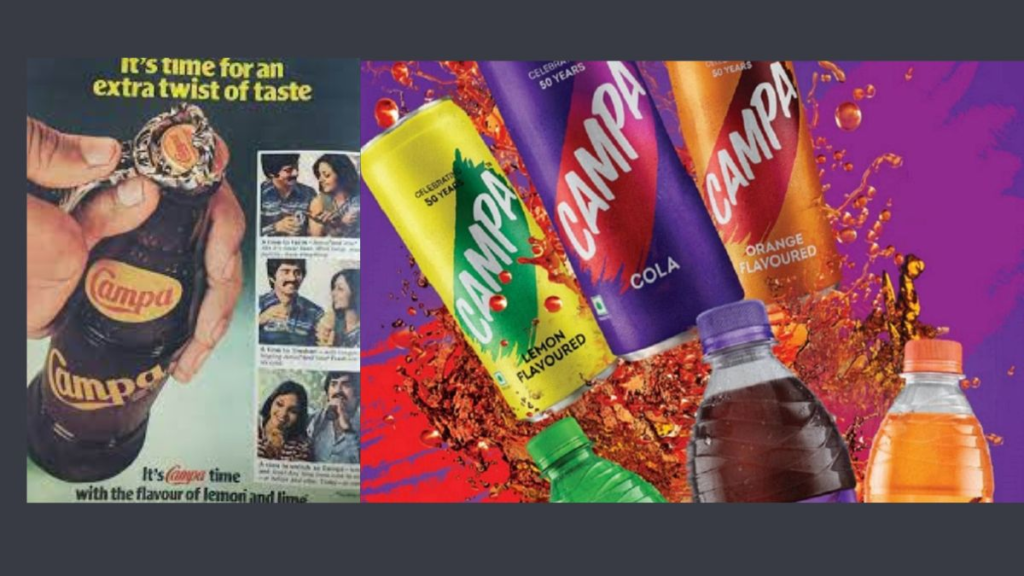The Financial Express
Campa Cola, the once-popular carbonated soft drink (CSD) brand with the “great Indian taste”, has returned to the shop shelves months after Reliance Consumer Products bought the brand from Pure Drinks Group for roughly Rs 22 crore. With the distribution muscle of Reliance behind it and it being priced a notch lower than competitors, the brand has the potential to shake up the Rs 45,000 crore Indian branded non-alcoholic beverage (BNAB) market.
But will that be enough?
First, look at the market dynamics. With roughly Rs 17,000 crore, CSDs enjoy the biggest share of the BNAB market, followed by fruit drinks at Rs 16,000 crore, dairy beverages at Rs 5,000 crore, nectars at Rs 2,000 crore, and traditional beverages at Rs 1,500 crore.
The key players in the space are Coca-Cola, PepsiCo, Parle, Dabur, ITC, and a handful of regional brands. In the cola space, Coca-Cola and Pepsico enjoy clear dominance, hogging more than 80% of the market between them. But they’re operating under tough conditions.
“The cola CSD market is witnessing headwinds (4% growth) as consumers are moving towards healthier beverages (12-15% growth),” says Angshuman Bhattacharya, partner and national leader of the consumer products and retail sector of EY India. “In this context, CSD is a tough and highly competitive category, hinged on bottling and distribution strengths.”
Campa needs mammoth investments to scale the business, he opines. That wouldn’t be very difficult, backed as it is by the country’s largest retailer.
Samit Sinha, managing partner, Alchemist Brand Consulting, says, “To achieve wide distribution, Reliance might have to offer deep discounts to trade, but I don’t think a price difference alone will help. There is a limit to how low you can price the product as there are costs over and above just making the drink. Packaging and size innovations can make all the difference.” Reliance will be banking on its strong petrochem back-end for that, says an observer.
Challenges ahead
The drink will be made available in over a million B2B outlets, general trade stores, e-commerce websites, and even B2C channels in the next year and a half. Observers say most of the marketing and communication efforts would be targeted at “Bharat” — rural and semi-urban India — where a majority of the Indian population resides, and where consumers might not be very loyal to any particular brand. The company is banking on those who do not ask for any particular label, but for something “thanda” to quench their thirst.
In the first phase of roll-out, Campa is available in Andhra Pradesh and Telangana. A 200-ml bottle of the drink is priced at Rs 10, versus Rs 20 for a 250-ml bottle of a Coke or a Pepsi. With reports of Coca-Cola slashing the price of its drink emerging, distributors have raised concerns over a possible price war that might affect their margins.
When asked to comment on the reports, a spokesperson of The Coca-Cola Company said, “We have broadly kept the same prices since last year for all our entry packs. Consumer centricity plays a prominent role in all Coca-Cola operations. Having new players in the market presents a great opportunity for investments to develop the market further.”
Analysts say there won’t be any knee-jerk reaction from other players in the market. Says Siddharth Devnani, co-founder & director, SoCheers, “I don’t expect the incumbents to play the price game because their strength lies in distribution. But the market dynamics can change within a year or so.”
There are other challenges to deal with. Alchemist’s Sinha says recall is a key asset for any brand and it would be wrong to ascribe too much weightage to Campa’s “nostalgia” value. “One has to remember that brand Campa Cola would not mean anything for three out of four Indians, because they were not born when the drink was around. For Gen Z and Millenials, this would not ring many bells at all. The issue is that a bulk of the cola-drinking population is in their teens and to some extent, are young adults. Therefore, for Campa Cola to address that segment, it will have to work like a new brand. It cannot rely on nostalgia and residual memories alone,” he said.
Another issue is the preponderance of impulse purchases in this category. A brand has to penetrate deep into a market to be available at the right place at the right time. Coca-Cola and Pepsico have a head-start in this regard. Apart from local stores, they have exclusive arrangements with fast food chains such as McDonald’s and KFC. That means these are not available for Campa to grab. It will eventually have to tie up with other chains and restaurants for trials, which is a time-consuming affair.
Finally, Sinha points out that those living in smaller towns and semi-urban areas also aspire to live the metropolitan life. Therefore it would be a fallacy to assume they wouldn’t aspire for a Coke or a Pepsi that have a largely urban appeal.
Follow us on Twitter, Instagram, LinkedIn, Facebook
Get live Share Market updates and latest India News and business news on Financial Express. Download Financial Express App for latest business news.

